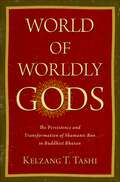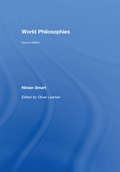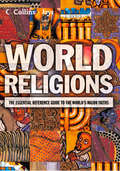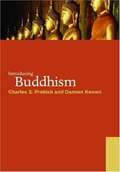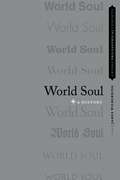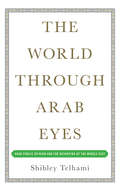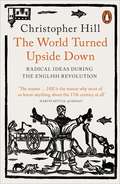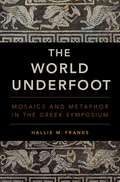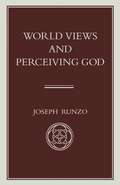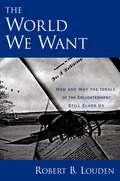- Table View
- List View
World of Worldly Gods: The Persistence and Transformation of Shamanic Bon in Buddhist Bhutan (AAR REFLECTION AND THEORY STU RELIGION)
by Kelzang T. TashiIn World of Worldly Gods, Kelzang T. Tashi offers the first comprehensive examination of the tenacity of Shamanic Bon practices, as they are lived and contested in the presence of an invalidating force: Buddhism. Through a rich ethnography of Goleng and nearby villages in central Bhutan, Tashi investigates why people, despite shifting contexts, continue to practice and engage with Bon, a religious practice that has survived over a millennium of impatience from a dominant Buddhist ecclesiastical structure. Against the backdrop of long-standing debates around practices unsystematically identified as 'bon', this book reframes the often stale and scholastic debates by providing a clear and succinct statement on how these practices should be conceived in the region. Tashi argues that the reasons for the tenacity of Bon practices and beliefs amid censures by the Buddhist priests are manifold and complex. While a significant reason for the persistence of Bon is the recency of formal Buddhist institutions in Goleng, he demonstrates that Bon beliefs are so deeply embedded in village social life that some Buddhists paradoxically feel it necessary to reach some kind of accommodation with Bon priests. Through an analysis of the relationship between Shamanic Bon and Buddhism, and the contemporary dynamics of Bhutanese society, this book tackles the longstanding concern of anthropology: cultural persistence and change. It discusses the mutual accommodation and attempted amalgamation of Buddhism and Bon, and offers fresh perspectives on the central distinguishing features of Great and Little Traditions.
World of Worldly Gods: The Persistence and Transformation of Shamanic Bon in Buddhist Bhutan (AAR REFLECTION AND THEORY STU RELIGION)
by Kelzang T. TashiIn World of Worldly Gods, Kelzang T. Tashi offers the first comprehensive examination of the tenacity of Shamanic Bon practices, as they are lived and contested in the presence of an invalidating force: Buddhism. Through a rich ethnography of Goleng and nearby villages in central Bhutan, Tashi investigates why people, despite shifting contexts, continue to practice and engage with Bon, a religious practice that has survived over a millennium of impatience from a dominant Buddhist ecclesiastical structure. Against the backdrop of long-standing debates around practices unsystematically identified as 'bon', this book reframes the often stale and scholastic debates by providing a clear and succinct statement on how these practices should be conceived in the region. Tashi argues that the reasons for the tenacity of Bon practices and beliefs amid censures by the Buddhist priests are manifold and complex. While a significant reason for the persistence of Bon is the recency of formal Buddhist institutions in Goleng, he demonstrates that Bon beliefs are so deeply embedded in village social life that some Buddhists paradoxically feel it necessary to reach some kind of accommodation with Bon priests. Through an analysis of the relationship between Shamanic Bon and Buddhism, and the contemporary dynamics of Bhutanese society, this book tackles the longstanding concern of anthropology: cultural persistence and change. It discusses the mutual accommodation and attempted amalgamation of Buddhism and Bon, and offers fresh perspectives on the central distinguishing features of Great and Little Traditions.
World Philosophies
by Ninian Smart Oliver LeamanWorld Philosophies presents in one volume a superb introduction to all the world’s major philosophical and religious traditions. Covering all corners of the globe, Ninian Smart’s work offers a comprehensive and global philosophical and religious picture. In this revised and expanded second edition, a team of distinguished scholars, assembled by the editor Oliver Leaman, have brought Ninian Smart’s masterpiece up to date for the twenty-first century. Chapters have been revised by experts in the field to include recent philosophical developments, and the book includes a new bibliographic guide to resources in world philosophies. A brand new introduction which celebrates the career and writings of Ninian Smart, and his contribution to the study of world religions, helps set the work in context.
World Philosophies
by Ninian Smart Oliver LeamanWorld Philosophies presents in one volume a superb introduction to all the world’s major philosophical and religious traditions. Covering all corners of the globe, Ninian Smart’s work offers a comprehensive and global philosophical and religious picture. In this revised and expanded second edition, a team of distinguished scholars, assembled by the editor Oliver Leaman, have brought Ninian Smart’s masterpiece up to date for the twenty-first century. Chapters have been revised by experts in the field to include recent philosophical developments, and the book includes a new bibliographic guide to resources in world philosophies. A brand new introduction which celebrates the career and writings of Ninian Smart, and his contribution to the study of world religions, helps set the work in context.
World Religions: The Esential Reference Guide To The World's Major Faiths (Collins Keys)
by CollinsA compact and informative guide to the key tenets, rituals and history of the world’s major faiths, now in a new easy-reference format.
World Religions: Introducing Buddhism (PDF)
by Charles S. PrebishIntroducing Buddhism is the ideal resource for all students beginning the study of this fascinating religion. Charles S. Prebish and Damien Keown, two of today's leading Buddhist scholars, explain the key teachings of Buddhism, and trace the historical development and spread of the religion from its beginnings down to the present day. A chapter is devoted to each of the major regions where Buddhism has flourished: India, South East Asia, East Asia and Tibet. In addition to this regional focus, the introduction takes contemporary concerns into account, covering important and relevant topics such as Engaged Buddhism, Buddhist Ethics and Buddhism and the Western World, as well as a chapter devoted to Meditation.
World Religions for Healthcare Professionals
by Mark F. Carr Siroj Sorajjakool Ernest J. BurseyThis third edition of a popular text introduces healthcare students and professionals to a wide range of health beliefs and practices in world religions. Chapters on various religions are written to offer an insider’s view on the religion’s historical development, key beliefs and practices, including ideas of health, sickness, death, and dying. The chapters include case studies, advice on what to do and what to avoid when caring for patients. Introductory chapters invite the reader to consider the broad context of patient care in pluralistic society and explore one’s personal orientation to others from different religions. How we care for patients from different backgrounds and cultures insists on professional boundaries that the reader may have not yet examined. A new chapter explores the relationship between religion and public health in light of the COVID-19 pandemic, asking the reader to consider what morally appropriate balance is required if and when personal faith conflict with public health needs. Undoubtedly, the sensitivity with which clinicians communicate with patients and make decisions regarding appropriate medical intervention can be greatly increased by an understanding of religious and cultural diversity. This is a core textbook for students studying healthcare, religion and culture, and an invaluable reference for healthcare professionals.
World Religions for Healthcare Professionals
This third edition of a popular text introduces healthcare students and professionals to a wide range of health beliefs and practices in world religions. Chapters on various religions are written to offer an insider’s view on the religion’s historical development, key beliefs and practices, including ideas of health, sickness, death, and dying. The chapters include case studies, advice on what to do and what to avoid when caring for patients. Introductory chapters invite the reader to consider the broad context of patient care in pluralistic society and explore one’s personal orientation to others from different religions. How we care for patients from different backgrounds and cultures insists on professional boundaries that the reader may have not yet examined. A new chapter explores the relationship between religion and public health in light of the COVID-19 pandemic, asking the reader to consider what morally appropriate balance is required if and when personal faith conflict with public health needs. Undoubtedly, the sensitivity with which clinicians communicate with patients and make decisions regarding appropriate medical intervention can be greatly increased by an understanding of religious and cultural diversity. This is a core textbook for students studying healthcare, religion and culture, and an invaluable reference for healthcare professionals.
World Religions in Practice: A Comparative Introduction
by Paul GwynneWorld Religions in Practice introduces five of the world's great religions – Hinduism, Buddhism, Judaism, Christianity, and Islam – and explores how they are lived and expressed in custom, ritual, and symbol. A major new textbook exploring the world's great religions through their customs, rituals and everyday practices – by focusing on this 'lived experience' it goes beyond many traditional introductions to religious studies Adopts a directly comparative approach to develop a greater understanding of the nature of religion Each chapter engages with an individual theme, such as birth, death, food, pilgrimage and ethics, to illustrate how religious practices are expressed Broadens students' understanding by offering an impartial discussion of the similarities and differences between each religion Includes chapter-by-chapter opening themes and summaries, and will be accompanied by a website at www.blackwellpublishing.com/gwynne featuring additional resources and study questions.
World Religions in Practice: A Comparative Introduction
by Paul GwynneA new and expanded edition of a highly successful textbook on world religions with a comparative approach which explores how six major religions are lived and expressed through their customs, rituals and everyday practices. A new edition of this major textbook, exploring the world's great religions through their customs, rituals and everyday practices by focusing on the 'lived experience' This comparative study is enriched and broadened with the inclusion of a sixth religion, Daoism Takes a thematic, comparative and practical approach; each chapter explores a series of key themes including birth, death, ethics, and worship across all six religions at each time Broadens students' understanding by offering an impartial discussion of the similarities and differences between each religion Includes an increased range of student-friendly features, designed to allow students to engage with each religion and extend their understanding
World Religions in Practice: A Comparative Introduction
by Paul GwynneA new and expanded edition of a highly successful textbook on world religions with a comparative approach which explores how six major religions are lived and expressed through their customs, rituals and everyday practices. A new edition of this major textbook, exploring the world's great religions through their customs, rituals and everyday practices by focusing on the 'lived experience' This comparative study is enriched and broadened with the inclusion of a sixth religion, Daoism Takes a thematic, comparative and practical approach; each chapter explores a series of key themes including birth, death, ethics, and worship across all six religions at each time Broadens students' understanding by offering an impartial discussion of the similarities and differences between each religion Includes an increased range of student-friendly features, designed to allow students to engage with each religion and extend their understanding
A World Religions Reader
by Ian S. Markham Christy Lohr SappA comprehensive and accessible textbook which explores the traditions and beliefs of the world’s living religions – the fully updated and revised new edition The World Religions Reader is an inclusive, student-friendly examination of the history, teaching, practices, and appeal of the world’s major religions. Covering both the fundamentals and complexities of each religious tradition, this popular textbook brings together significant texts from scriptures and scholars, as well as writings from philosophers and other significant thinkers throughout history. Students are provided with an introduction and overview of the tradition, taken through its primary texts, and presented with a text which seeks to persuade the student of the tradition’s merits. This new edition has been thoroughly updated to be even more accessible for students new to interreligious engagement and to reflect current trends and developments in religions worldwide. Every chapter opens with a substantial overview which orients the new student and then flows into a carefully chosen set of texts - a regular textbook is now combined with a Reader. New content examines areas such as the Rastafarian tradition, while revised chapters cover secular humanism and indigenous and emerging religious traditions. The methodology of the book focuses on an empathetic approach – representing each tradition from the perspective of a conventional adherent – enabling students to develop understanding of each tradition and appreciate similarities and differences in their most typical forms. Invites students to study each tradition from the perspective of a follower, aiming to understand why the tradition is popular and powerful Explores representative passages, world-views, rituals and institutions, ethical expressions and modern outlooks for each religion Features discussions of interfaith perspectives on the role of women in religious traditions and the impact of world events and politics on interfaith communication Encourages students to consider questions of truth, the relation of religion and society, and the changing nature of a tradition in the modern world Includes a complete set of pedagogical tools and instructor resources, including end-of-chapter fact sheets, topic summaries, key term sections, and essay and discussion questions The World Religions Reader, Fourth Edition is an ideal textbook for undergraduate and graduate courses in religion, especially for liberal arts and non-affiliated colleges, as well as general readers wishing to increase their knowledge of the world’s religious traditions.
A World Religions Reader (Wiley Desktop Editions Ser.)
by Ian S. Markham Christy Lohr SappA comprehensive and accessible textbook which explores the traditions and beliefs of the world’s living religions – the fully updated and revised new edition The World Religions Reader is an inclusive, student-friendly examination of the history, teaching, practices, and appeal of the world’s major religions. Covering both the fundamentals and complexities of each religious tradition, this popular textbook brings together significant texts from scriptures and scholars, as well as writings from philosophers and other significant thinkers throughout history. Students are provided with an introduction and overview of the tradition, taken through its primary texts, and presented with a text which seeks to persuade the student of the tradition’s merits. This new edition has been thoroughly updated to be even more accessible for students new to interreligious engagement and to reflect current trends and developments in religions worldwide. Every chapter opens with a substantial overview which orients the new student and then flows into a carefully chosen set of texts - a regular textbook is now combined with a Reader. New content examines areas such as the Rastafarian tradition, while revised chapters cover secular humanism and indigenous and emerging religious traditions. The methodology of the book focuses on an empathetic approach – representing each tradition from the perspective of a conventional adherent – enabling students to develop understanding of each tradition and appreciate similarities and differences in their most typical forms. Invites students to study each tradition from the perspective of a follower, aiming to understand why the tradition is popular and powerful Explores representative passages, world-views, rituals and institutions, ethical expressions and modern outlooks for each religion Features discussions of interfaith perspectives on the role of women in religious traditions and the impact of world events and politics on interfaith communication Encourages students to consider questions of truth, the relation of religion and society, and the changing nature of a tradition in the modern world Includes a complete set of pedagogical tools and instructor resources, including end-of-chapter fact sheets, topic summaries, key term sections, and essay and discussion questions The World Religions Reader, Fourth Edition is an ideal textbook for undergraduate and graduate courses in religion, especially for liberal arts and non-affiliated colleges, as well as general readers wishing to increase their knowledge of the world’s religious traditions.
The World Religions Speak on ”The Relevance of Religion in the Modern World” (World Academy of Art and Science)
by Finley P. DunneWorld Soul: A History (Oxford Philosophical Concepts)
by James WilberdingMany philosophers and scientists over the course of history have held that the world is alive. It has a soul, which governs it and binds it together. This suggestion, once so wide-spread, may strike many of us today as strange and antiquated--in fact, there are few other concepts that, on their face, so capture the sheer distance between us and our philosophical inheritance. But the idea of a world soul has held so strong a grip upon philosophers' imaginations for over 2,000 years, that it continues to underpin and even structure how we conceive of time and space. The concept of the world soul is difficult to understand in large part because over the course of history it has been invoked to very different ends and within the frameworks of very different ontologies and philosophical systems, with varying concepts of the world soul emerging as a result. This volume brings together eleven chapters by leading philosophers in their respective fields that collectively explore the various ways in which this concept has been understood and employed, covering the following philosophical areas: Platonism, Stoicism, Medieval, Indian or Vedântic, Kabbalah, Renaissance, Early Modern, German Romanticism, German Idealism, American Transcendentalism, and contemporary quantum mechanics and panpsychism theories. In addition, short reflections illuminate the impact the concept of the world soul has had on a small selection of areas outside of philosophy, such as harmony, the biological concept of spontaneous generation, Henry Purcell, psychoanalysis, and Gaia theories.
World Soul: A History (Oxford Philosophical Concepts)
Many philosophers and scientists over the course of history have held that the world is alive. It has a soul, which governs it and binds it together. This suggestion, once so wide-spread, may strike many of us today as strange and antiquated--in fact, there are few other concepts that, on their face, so capture the sheer distance between us and our philosophical inheritance. But the idea of a world soul has held so strong a grip upon philosophers' imaginations for over 2,000 years, that it continues to underpin and even structure how we conceive of time and space. The concept of the world soul is difficult to understand in large part because over the course of history it has been invoked to very different ends and within the frameworks of very different ontologies and philosophical systems, with varying concepts of the world soul emerging as a result. This volume brings together eleven chapters by leading philosophers in their respective fields that collectively explore the various ways in which this concept has been understood and employed, covering the following philosophical areas: Platonism, Stoicism, Medieval, Indian or Vedântic, Kabbalah, Renaissance, Early Modern, German Romanticism, German Idealism, American Transcendentalism, and contemporary quantum mechanics and panpsychism theories. In addition, short reflections illuminate the impact the concept of the world soul has had on a small selection of areas outside of philosophy, such as harmony, the biological concept of spontaneous generation, Henry Purcell, psychoanalysis, and Gaia theories.
The World Through Arab Eyes: Arab Public Opinion and the Reshaping of the Middle East
by Shibley TelhamiThe uprisings that transformed the Middle East beginning in 2011 have left experts scrambling to understand where the region is likely to go in years to come. But missing from most of the analysis is a longer view of the evolution of Arab Public opinion and identity and how this is likely to influence this fast-changing region. In The World Through Arab Eyes, Shibley Telhami shows how the roots of these rebellions stretch back decades and explains how they will continue to affect the stability of the Middle East in the years to come. Telhami draws on a decade's worth of polling data and analysis to provide a comprehensive look at this evolution of Arab identity and opinion. The demand for dignity, which was foremost in the chants of millions of Arab demonstrators, went far beyond being a struggle for "food” and individual rights. Telhami identifies the key prisms through which Arabs view issues ranging from democracy and religion to foreign actors, including the United States, European and Asian countries, Iran, Turkey, and, centrally, Israel. These prisms provide a key to interpreting the past, comprehending the seismic changes in Arab politics today, and engaging with the region in the future.
The World Turned Upside Down: Radical Ideas During the English Revolution (Peregrine Bks.)
by Christopher Hill'His finest work and one that was both symptom and engine of the concept of "history from below" ... Here Levellers, Diggers, Ranters, Muggletonians, the early Quakers and others taking advantage of the collapse of censorship to bid for new kinds of freedom were given centre stage ... Hill lives on' Times Higher EducationIn 'The World Turned Upside Down' Christopher Hill studies the beliefs of such radical groups as the Diggers, the Ranters, the Levellers and others, and the social and emotional impulses that gave rise to them. The relations between rich and poor classes, the part played by wandering 'masterless' men, the outbursts of sexual freedom, the great imaginative creations of Milton and Bunyan - these and many other elements build up into a marvellously detailed and coherent portrait of this strange, sudden effusion of revolutionary beliefs.'Established the concept of an "English Revolution" every bit as significant and potentially as radical as its French and Russian equivalents' Daily Telegraph'Brilliant ... marvellous erudition and sympathy' David Caute, New Statesman'This book will outlive our time and will stand as a notable monument to the man, the committed radical scholar, and one of the finest historians of the age' The Times Literary Supplement'The dean and paragon of English historians' E.P. Thompson
The World Underfoot: Mosaics and Metaphor in the Greek Symposium
by Hallie M. FranksIn the Greek Classical period, the symposium--the social gathering at which male citizens gathered to drink wine and engage in conversation--was held in a room called the andron. From couches set up around the perimeter, symposiasts looked inward to the room's center, which often was decorated with a pebble mosaic floor. These mosaics provided visual treats for the guests, presenting them with images of mythological scenes, exotic flora, dangerous beasts, hunting parties, or the spectre of Dionysos: the god of wine, riding in his chariot or on the back of a panther. In The World Underfoot, Hallie M. Franks takes as her subject these mosaics and the context of their viewing. Relying on discourses in the sociology and anthropology of space, she presents an innovative new interpretation of the mosaic imagery as an active contributor to the symposium as a metaphorical experience. Franks argues that the images on mosaic floors, combined with the ritualized circling of the wine cup and the physiological reaction to wine during the symposium, would have called to mind other images, spaces, or experiences, and in doing so, prompted drinkers to reimagine the symposium as another kind of event--a nautical voyage, a journey to a foreign land, the circling heavens or a choral dance, or the luxury of an abundant past. Such spatial metaphors helped to forge the intimate bonds of friendship that are the ideal result of the symposium and that make up the political and social fabric of the Greek polis.
The World Underfoot: Mosaics and Metaphor in the Greek Symposium
by Hallie M. FranksIn the Greek Classical period, the symposium--the social gathering at which male citizens gathered to drink wine and engage in conversation--was held in a room called the andron. From couches set up around the perimeter, symposiasts looked inward to the room's center, which often was decorated with a pebble mosaic floor. These mosaics provided visual treats for the guests, presenting them with images of mythological scenes, exotic flora, dangerous beasts, hunting parties, or the spectre of Dionysos: the god of wine, riding in his chariot or on the back of a panther. In The World Underfoot, Hallie M. Franks takes as her subject these mosaics and the context of their viewing. Relying on discourses in the sociology and anthropology of space, she presents an innovative new interpretation of the mosaic imagery as an active contributor to the symposium as a metaphorical experience. Franks argues that the images on mosaic floors, combined with the ritualized circling of the wine cup and the physiological reaction to wine during the symposium, would have called to mind other images, spaces, or experiences, and in doing so, prompted drinkers to reimagine the symposium as another kind of event--a nautical voyage, a journey to a foreign land, the circling heavens or a choral dance, or the luxury of an abundant past. Such spatial metaphors helped to forge the intimate bonds of friendship that are the ideal result of the symposium and that make up the political and social fabric of the Greek polis.
World Upside Down: Reading Acts in the Graeco-Roman Age
by C. Kavin RoweFor almost 300 years, the dominant trend in New Testament interpretation has been to read the Acts of the Apostles as a document that argues for the political possibility of harmonious co-existence between 'Rome' and the early Christian movement. Kavin Rowe argues that the time is long overdue for a sophisticated, critically constructive reappraisal. "A brilliant piece of work by a young scholar of considerable promise." --First Things "This well-written, well-argued book is a must read for New Testament scholars." -- Review of Biblical Literature "This sophisticated argument offers a comprehensive vision of Acts and deserves a wide readership." -- Religious Studies Review "There is so much happening in these pages that a slow and careful read will provoke sustained thoughts on a variety of subjects of ecclesial interest ranging from Christianity and culture to issues of tolerance and political theology." -- Themelios
World Upside Down: Reading Acts in the Graeco-Roman Age
by C. Kavin RoweFor almost 300 years, the dominant trend in New Testament interpretation has been to read the Acts of the Apostles as a document that argues for the political possibility of harmonious co-existence between 'Rome' and the early Christian movement. Kavin Rowe argues that the time is long overdue for a sophisticated, critically constructive reappraisal. "A brilliant piece of work by a young scholar of considerable promise." --First Things "This well-written, well-argued book is a must read for New Testament scholars." -- Review of Biblical Literature "This sophisticated argument offers a comprehensive vision of Acts and deserves a wide readership." -- Religious Studies Review "There is so much happening in these pages that a slow and careful read will provoke sustained thoughts on a variety of subjects of ecclesial interest ranging from Christianity and culture to issues of tolerance and political theology." -- Themelios
World Views and the Problem of Synthesis: The Yellow Book of “Einstein Meets Magritte” (Einstein Meets Magritte: An Interdisciplinary Reflection on Science, Nature, Art, Human Action and Society #4)
by JanVeken HubertBelle DiederikAertsThis book considers philosophy to be more than mere reflection. Through philosophy, humankind can give meaning to the world. In part, this book re-evaluates the philosophy of Leo Apostel, who dedicated his life to the investigation of the use of philosophy in everyday life. But it is also a presentation of international research carried out along the lines of the worldviews project. The contributions address not only professional philosophers, but also students, teachers, academics and everyone interested in the relationship between philosophy and the world.
The World We Want: How and Why the Ideals of the Enlightenment Still Elude Us
by Robert B. LoudenThe World We Want compares the future world that Enlightenment intellectuals had hoped for with our own world at present. In what respects do the two worlds differ, and why are they so different? To what extent is and isn't our world the world they wanted, and to what extent do we today still want their world? Unlike previous philosophical critiques and defenses of the Enlightenment, the present study focuses extensively on the relevant historical and empirical record first, by examining carefully what kind of future Enlightenment intellectuals actually hoped for; second, by tracking the different legacies of their central ideals over the past two centuries. But in addition to documenting the significant gap that still exists between Enlightenment ideals and current realities, the author also attempts to show why the ideals of the Enlightenment still elude us. What does our own experience tell us about the appropriateness of these ideals? Which Enlightenment ideals do not fit with human nature? Why is meaningful support for these ideals, particularly within the US, so weak at present? Which of the means that Enlightenment intellectuals advocated for realizing their ideals are inefficacious? Which of their ideals have devolved into distorted versions of themselves when attempts have been made to realize them? How and why, after more than two centuries, have we still failed to realize the most significant Enlightenment ideals? In short, what is dead and what is living in these ideals?
